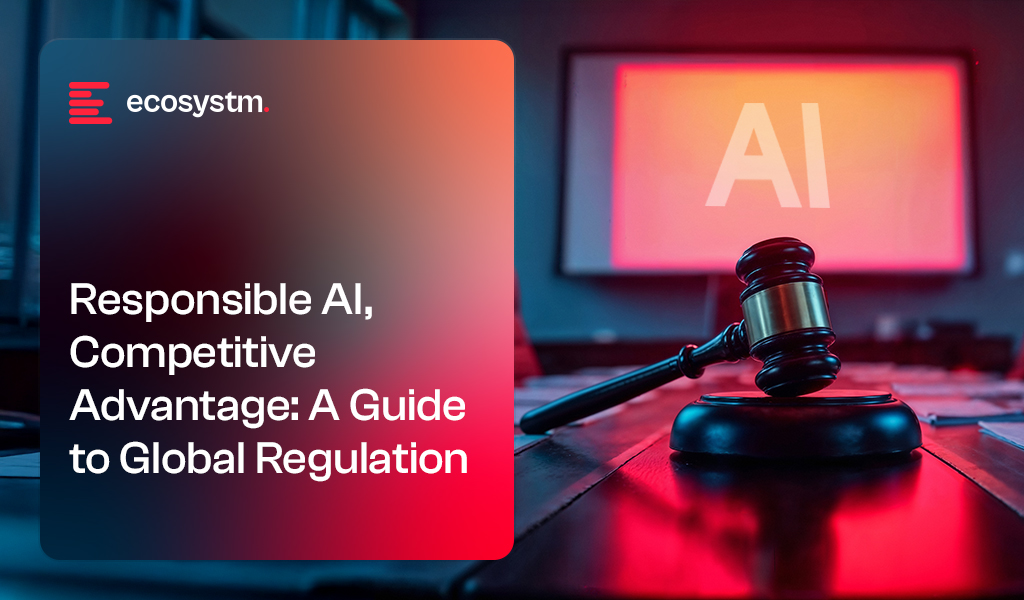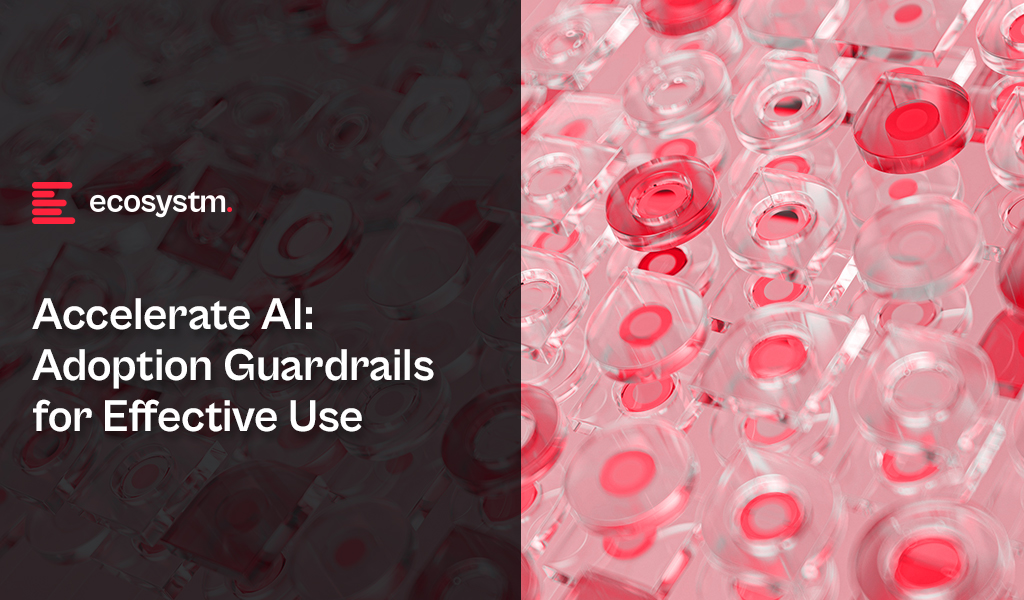AI can no longer be treated as a side experiment; it is often embedded in core decisions, customer experiences, operations, and innovation. And as adoption accelerates, so does regulatory scrutiny. Around the world, governments are moving quickly to set rules on how AI can be used, what risks must be controlled, and who is held accountable when harm occurs.
This shift makes Responsible AI a strategic imperative – not just a compliance checkbox. It’s about reducing reputational risk, protecting customers and IP, and earning the trust needed to scale AI responsibly. Embedding transparency, fairness, and accountability into AI systems isn’t just ethical, it’s smart business.
Understanding the regulatory landscape is a key part of that responsibility. As frameworks evolve, organisations must stay ahead of the rules shaping AI and ensure leadership is asking the right questions.
EU AI Act: Setting the Standard for Responsible AI
The EU AI Act is the world’s first comprehensive legislative framework for AI. It introduces a risk-based classification system: minimal, limited, high, and unacceptable. High-risk applications, including those used in HR, healthcare, finance, law enforcement, and critical infrastructure, must comply with strict requirements around transparency, data governance, ongoing monitoring, and human oversight. Generative AI models above certain thresholds are also subject to obligations such as disclosing training data sources and ensuring content integrity.
Although an EU regulation, the Act has global relevance. Organisations outside the EU may fall within its scope if their AI systems impact EU citizens or markets. And just as the GDPR became a de facto global standard for data protection, the EU AI Act is expected to create a ripple effect, shaping how other countries approach AI regulation. It sets a clear precedent for embedding safety, accountability, and human-centric principles into AI governance. As a result, it is one of the most closely tracked developments by compliance teams, risk officers, and AI governance leads worldwide.
However, as AI governance firms up worldwide, Asia Pacific organisations must look beyond Europe. From Washington to Beijing, several regulatory frameworks are rapidly influencing global norms. Whether organisations are building, deploying, or partnering on AI, these five are shaping the rules of the game.
AI Regulations Asia Pacific Organisations Must Track
1. United States: Setting the Tone for Global AI Risk Management
The U.S. Executive Order on AI (2023) signals a major policy shift in federal oversight. It mandates agencies to establish AI safety standards, governance protocols, and risk assessment practices, with an emphasis on fairness, explainability, and security, especially in sensitive domains like healthcare, employment, and finance. Central to this effort is the NIST AI Risk Management Framework (AI RMF), quickly emerging as a global touchstone.
Though designed as domestic policy, the Order’s influence is global. It sets a high bar for what constitutes responsible AI and is already shaping procurement norms and international expectations. For Asia Pacific organisations, early alignment isn’t just about accessing the U.S. market; it’s about maintaining credibility and competitiveness in a global AI landscape that is rapidly converging around these standards.
Why it matters to Asia Pacific organisations
- Global Supply Chains Depend on It. U.S.-linked firms must meet stringent AI safety and procurement standards to stay viable. Falling short could mean loss of market and partnership access.
- NIST Is the New Global Benchmark. Aligning with AI RMF enables consistent risk management and builds confidence with global regulators and clients.
- Explainability Is Essential. AI systems must provide auditable, transparent decisions to satisfy legal and market expectations.
- Security Isn’t Optional. Preventing misuse and securing models is a non-negotiable baseline for participation in global AI ecosystems.
2. China: Leading with Strict GenAI Regulation
China’s 2023 Generative AI Measures impose clear rules on public-facing GenAI services. Providers must align content with “core socialist values,” prevent harmful bias, and ensure outputs are traceable and verifiable. Additionally, algorithms must be registered with regulators, with re-approval required for significant changes. These measures embed accountability and auditability into AI development and signal a new standard for regulatory oversight.
For Asia Pacific organisations, this is more than compliance with local laws; it’s a harbinger of global trends. As major economies adopt similar rules, embracing traceability, algorithmic governance, and content controls now offers a competitive edge. It also demonstrates a commitment to trustworthy AI, positioning firms as serious players in the future global AI market.
Why it matters to Asia Pacific organisations
- Regulatory Access and Avoiding Risk. Operating in or reaching Chinese users means strict content and traceability compliance is mandatory.
- Global Trend Toward Algorithm Governance. Requirements like algorithm registration are becoming regional norms and early adoption builds readiness.
- Transparency and Documentation. Rules align with global moves toward auditability and explainability.
- Content and Data Localisation. Businesses must invest in moderation and rethink infrastructure to comply with China’s standards.
3. Singapore: A Practical Model for Responsible AI
Singapore’s Model AI Governance Framework, developed by IMDA and PDPC, offers a pragmatic and principles-led path to ethical AI. Centred on transparency, human oversight, robustness, fairness, and explainability, the framework is accompanied by a detailed implementation toolkit, including use-case templates and risk-based guidance. It’s a practical playbook for firms looking to embed responsibility into their AI systems from the start.
For Asia Pacific organisations, Singapore’s approach serves as both a local standard and a launchpad for global alignment. Adopting it enables responsible innovation, prepares teams for tighter compliance regimes, and builds trust with stakeholders at home and abroad. It’s a smart move for firms seeking to lead responsibly in the region’s growing AI economy.
Why it matters to Asia Pacific organisations
- Regionally Rooted, Globally Relevant. Widely adopted across Southeast Asia, the framework suits industries from finance to logistics.
- Actionable Tools for Teams. Templates and checklists make responsible AI real and repeatable at scale.
- Future Compliance-Ready. Even if voluntary now, it positions firms to meet tomorrow’s regulations with ease.
- Trust as a Strategic Asset. Emphasising fairness and oversight boosts buy-in from regulators, partners, and users.
- Global Standards Alignment. Harmonises with the NIST RMF and G7 guidance, easing cross-border operations.
4. OECD & G7: The Foundations of Global AI Trust
The OECD AI Principles, adopted by over 40 countries, and the G7 Hiroshima Process establish a high-level consensus on what trustworthy AI should look like. They champion values such as transparency, accountability, robustness, and human-centricity. The G7 further introduced voluntary codes for foundation model developers, encouraging practices like documenting limitations, continuous risk testing, and setting up incident reporting channels.
For Asia Pacific organisations, these frameworks are early indicators of where global regulation is heading. Aligning now sends a strong signal of governance maturity, supports safer AI deployment, and strengthens relationships with investors and international partners. They also help firms build scalable practices that can evolve alongside regulatory expectations.
Why it matters to Asia Pacific organisations
- Blueprint for Trustworthy AI. Principles translate to real-world safeguards like explainability and continuous testing.
- Regulatory Foreshadowing. Many Asia Pacific countries cite these frameworks in shaping their own AI policies.
- Investor and Partner Signal. Compliance demonstrates maturity to stakeholders, aiding capital access and deals.
- Safety Protocols for Scale. G7 recommendations help prevent AI failures and harmful outcomes.
- Enabler of Cross-Border Collaboration. Global standards support smoother AI export, adoption, and partnership.
5. Japan: Balancing Innovation and Governance
Japan’s AI governance, guided by its 2022 strategy and active role in the G7 Hiroshima Process, follows a soft law approach that encourages voluntary adoption of ethical principles. The focus is on human-centric, transparent, and safe AI, allowing companies to experiment within defined ethical boundaries without heavy-handed mandates.
For Asia Pacific organisations, Japan offers a compelling governance model that supports responsible innovation. By following its approach, firms can scale AI while staying aligned with international norms and anticipating formal regulations. It’s a flexible yet credible roadmap for building internal AI governance today.
Why it matters to Asia Pacific organisations
- Room to Innovate with Guardrails. Voluntary guidelines support agile experimentation without losing ethical direction.
- Emphasis on Human-Centred AI. Design principles prioritise user rights and build long-term trust.
- G7-Driven Interoperability. As a G7 leader, Japan’s standards help companies align with broader international norms.
- Transparency and Safety Matter. Promoting explainability and security sets firms apart in global markets.
- Blueprint for Internal Governance. Useful for creating internal policies that are regulation-ready.
Why This Matters: Beyond Compliance
The global regulatory patchwork is quickly evolving into a complex landscape of overlapping expectations. For multinational companies, this creates three clear implications:
- Compliance is no longer optional. With enforcement kicking in (especially under the EU AI Act), failure to comply could mean fines, blocked products, or reputational damage.
- Enterprise AI needs guardrails. Businesses must build not just AI products, but AI governance, covering model explainability, data quality, access control, bias mitigation, and audit readiness.
- Trust drives adoption. As AI systems touch more customer and employee experiences, being able to explain and defend AI decisions becomes essential for maintaining stakeholder trust.
AI regulation is not a brake on innovation; it’s the foundation for sustainable, scalable growth. For forward-thinking businesses, aligning with emerging standards today will not only reduce risk but also increase competitive advantage tomorrow. The organisations that win in the AI age will be the ones who combine speed with responsibility, and governance with ambition.

Home to over 60% of the global population, the Asia Pacific region is at the forefront of digital transformation – and at a turning point. The Asian Development Bank forecasts a USD 1.7T GDP boost by 2030, but only if regulation keeps pace with innovation. In 2025, that alignment is taking shape: regulators across the region are actively crafting policies and platforms to scale innovation safely and steer it toward public good. Their focus spans global AI rules, oversight of critical tech in BFSI, sustainable finance, green fintech, and frameworks for digital assets.
Here’s a look at some of the regulatory influences on the region’s BFSI organisations.
Click here to download “Greener, Smarter, Safer: BFSI’s Regulatory Agenda” as a PDF.
The Ripple Effect of Global AI Regulation on APAC Finance
The EU’s AI Act – alongside efforts by other countries such as Brazil and the UK – signals a global shift toward responsible AI. With mandates for transparency, accountability, and human oversight, the Act sets a new bar that resonates across APAC, especially in high-stakes areas like credit scoring and fraud detection.
For financial institutions in the region, ensuring auditable AI systems and maintaining high data quality will be key to compliance. But the burden of strict rules, heavy fines, and complex risk assessments may slow innovation – particularly for smaller fintechs. Global firms with a footprint in the EU also face the challenge of navigating divergent regulatory regimes, adding complexity and cost.
APAC financial institutions must strike a careful balance: safeguarding consumers while keeping innovation alive within a tightening regulatory landscape.
Stepping Up Oversight: Regulating Tech’s Role
Effective January 1, 2025, the UK has granted the Financial Conduct Authority (FCA) and Bank of England oversight of critical tech firms serving the banking sector. This underscores growing global recognition of the systemic importance of these providers.
This regulatory expansion has likely implications for major players such as AWS, Google, and Microsoft. The goal: strengthen financial stability by mitigating cyber risks and service disruptions.
As APAC regulators watch closely, a key question emerges: will similar oversight frameworks be introduced to protect the region’s increasingly interconnected financial ecosystem?
With heavy reliance on a few core tech providers, APAC must carefully assess systemic risks and the need for regulatory safeguards in shaping its digital finance future.
Catalysing Sustainable Finance Through Regional Collaboration
APAC policymakers are translating climate ambitions into tangible action, exemplified by the collaborative FAST-P initiative between Australia and Singapore, spearheaded by the Monetary Authority of Singapore (MAS).
Australia’s USD 50 million commitment to fintech-enabled clean energy and infrastructure projects across Southeast Asia demonstrates a powerful public-private partnership driving decarbonisation through blended finance models.
This regional collaboration highlights a proactive approach to leveraging financial innovation for sustainability, setting a potential benchmark for other APAC nations.
Fostering Green Fintech Innovation Across APAC Markets
The proactive stance on sustainable finance extends to initiatives promoting green fintech startups.
Hong Kong’s upcoming Green Fintech Map and Thailand’s expanded ESG Product Platform are prime examples. By spotlighting sustainability-focused digital tools and enhancing data infrastructure and disclosure standards, these regulators aim to build investor confidence in ESG-driven fintech offerings.
This trend underscores a clear regional strategy: APAC regulators are not merely encouraging green innovation but actively cultivating ecosystems that facilitate its growth and scalability across diverse markets.
Charting the Regulatory Course for Digital Asset Growth in APAC
APAC regulators are gaining momentum in building forward-looking frameworks for the digital asset landscape. Japan’s proposal to classify crypto assets as financial products, Hong Kong’s expanded permissions for virtual asset activities, and South Korea’s gradual reintroduction of corporate crypto trading all point to a proactive regulatory shift.
Australia’s new crypto rules, including measures against debanking, and India’s clarified registration requirements for key players further reflect a region moving from cautious observation to decisive action.
Regulators are actively shaping a secure, scalable digital asset ecosystem – striking a balance between innovation, strong compliance, and consumer protection.
Ecosystm Opinion
APAC regulators are sending a clear message: innovation and oversight go hand in hand. As the region embraces a digital-first future, governments are moving beyond rule-setting to design frameworks that actively shape the balance between innovation, markets, institutions, and society.
This isn’t just about following global norms; it’s a bold step toward defining new standards that reflect APAC’s unique ambitions and the realities of digital finance.

“AI Guardrails” are often used as a method to not only get AI programs on track, but also as a way to accelerate AI investments. Projects and programs that fall within the guardrails should be easy to approve, govern, and manage – whereas those outside of the guardrails require further review by a governance team or approval body. The concept of guardrails is familiar to many tech businesses and are often applied in areas such as cybersecurity, digital initiatives, data analytics, governance, and management.
While guidance on implementing guardrails is common, organisations often leave the task of defining their specifics, including their components and functionalities, to their AI and data teams. To assist with this, Ecosystm has surveyed some leading AI users among our customers to get their insights on the guardrails that can provide added value.
Data Security, Governance, and Bias
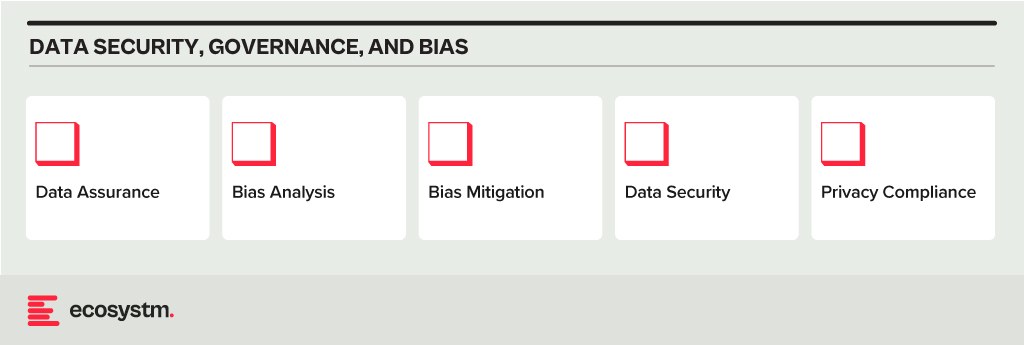
- Data Assurance. Has the organisation implemented robust data collection and processing procedures to ensure data accuracy, completeness, and relevance for the purpose of the AI model? This includes addressing issues like missing values, inconsistencies, and outliers.
- Bias Analysis. Does the organisation analyse training data for potential biases – demographic, cultural and so on – that could lead to unfair or discriminatory outputs?
- Bias Mitigation. Is the organisation implementing techniques like debiasing algorithms and diverse data augmentation to mitigate bias in model training?
- Data Security. Does the organisation use strong data security measures to protect sensitive information used in training and running AI models?
- Privacy Compliance. Is the AI opportunity compliant with relevant data privacy regulations (country and industry-specific as well as international standards) when collecting, storing, and utilising data?
Model Development and Explainability
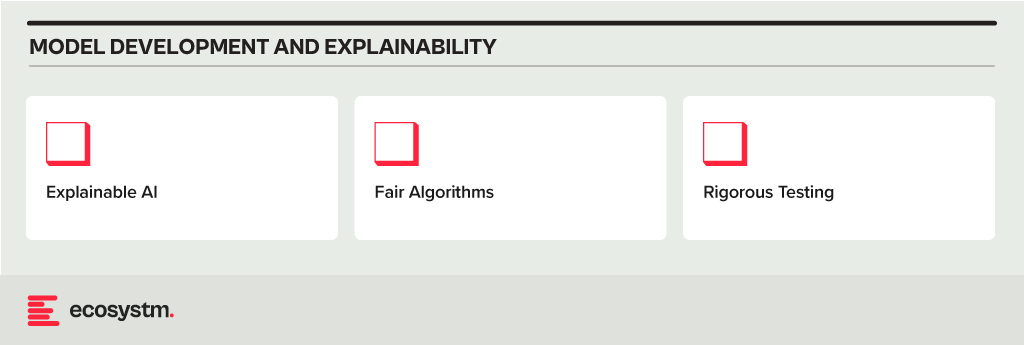
- Explainable AI. Does the model use explainable AI (XAI) techniques to understand and explain how AI models reach their decisions, fostering trust and transparency?
- Fair Algorithms. Are algorithms and models designed with fairness in mind, considering factors like equal opportunity and non-discrimination?
- Rigorous Testing. Does the organisation conduct thorough testing and validation of AI models before deployment, ensuring they perform as intended, are robust to unexpected inputs, and avoid generating harmful outputs?
AI Deployment and Monitoring
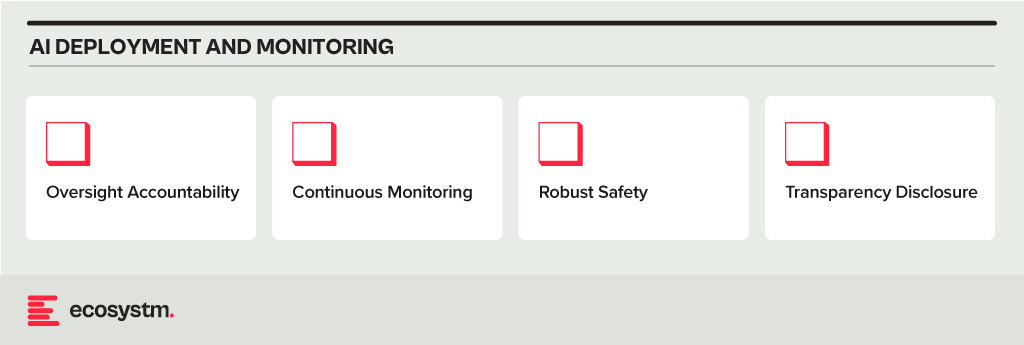
- Oversight Accountability. Has the organisation established clear roles and responsibilities for human oversight throughout the AI lifecycle, ensuring human control over critical decisions and mitigation of potential harm?
- Continuous Monitoring. Are there mechanisms to continuously monitor AI systems for performance, bias drift, and unintended consequences, addressing any issues promptly?
- Robust Safety. Can the organisation ensure AI systems are robust and safe, able to handle errors or unexpected situations without causing harm? This includes thorough testing and validation of AI models under diverse conditions before deployment.
- Transparency Disclosure. Is the organisation transparent with stakeholders about AI use, including its limitations, potential risks, and how decisions made by the system are reached?
Other AI Considerations
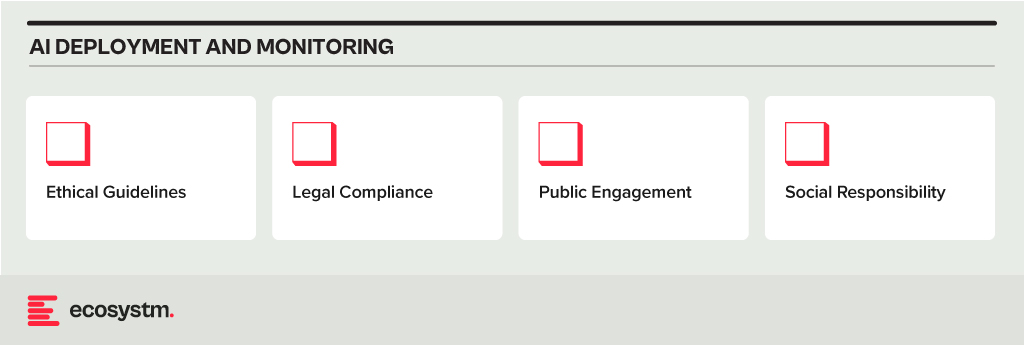
- Ethical Guidelines. Has the organisation developed and adhered to ethical principles for AI development and use, considering areas like privacy, fairness, accountability, and transparency?
- Legal Compliance. Has the organisation created mechanisms to stay updated on and compliant with relevant legal and regulatory frameworks governing AI development and deployment?
- Public Engagement. What mechanisms are there in place to encourage open discussion and engage with the public regarding the use of AI, addressing concerns and building trust?
- Social Responsibility. Has the organisation considered the environmental and social impact of AI systems, including energy consumption, ecological footprint, and potential societal consequences?
Implementing these guardrails requires a comprehensive approach that includes policy formulation, technical measures, and ongoing oversight. It might take a little longer to set up this capability, but in the mid to longer term, it will allow organisations to accelerate AI implementations and drive a culture of responsible AI use and deployment.



